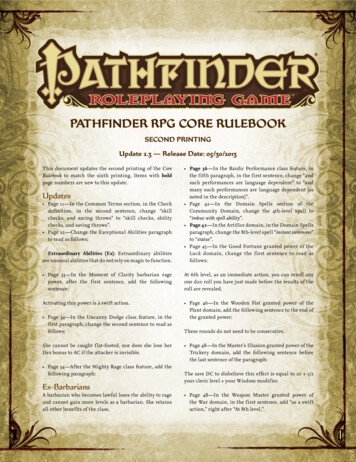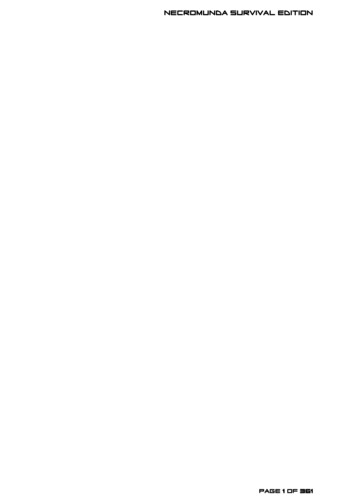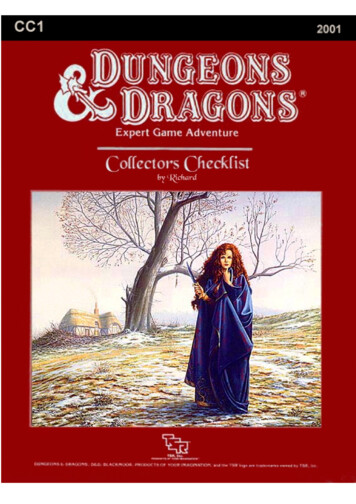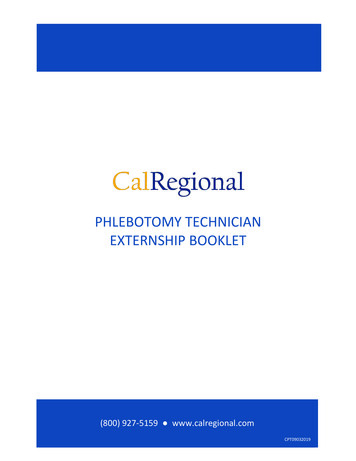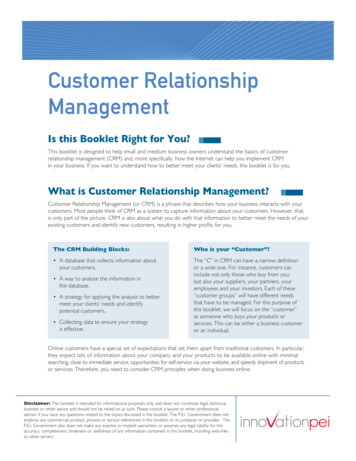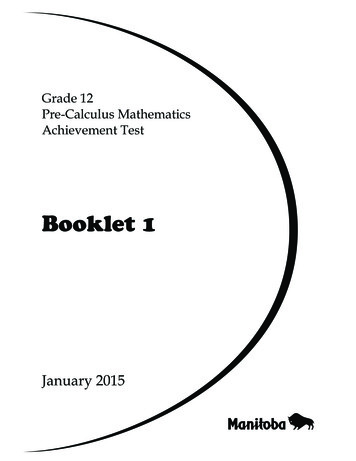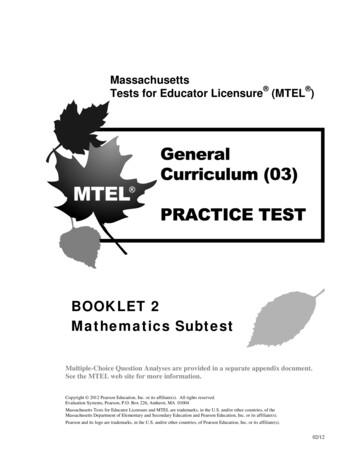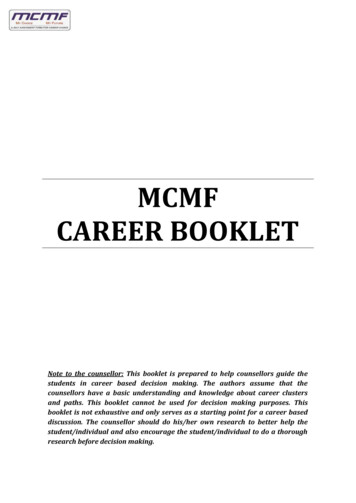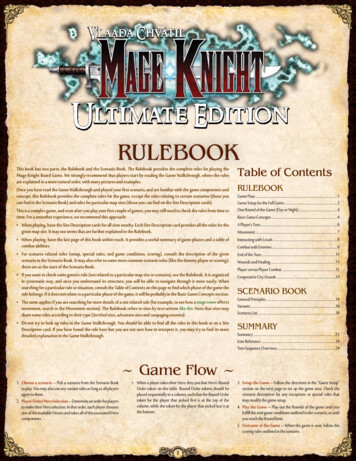
Transcription
RULEBOOKThis book has two parts, the Rulebook and the Scenario Book. The Rulebook provides the complete rules for playing theMage Knight Board Game. We strongly recommend that players start by reading the Game Walkthrough, where the rulesare explained in a more natural order, with many pictures and examples.Once you have read the Game Walkthrough and played your first scenario, and are familiar with the game components andconcept, this Rulebook provides the complete rules for the game, except the rules relating to certain scenarios (those youcan find in the Scenario Book) and rules for particular map sites (those you can find on the Site Description cards).This is a complex game, and even after you play your first couple of games, you may still need to check the rules from time totime. For a smoother experience, we recommend this approach: When playing, have the Site Description cards for all sites nearby. Each Site Description card provides all the rules for thegiven map site. It may use terms that are further explained in the Rulebook. When playing, have the last page of this book within reach. It provides a useful summary of game phases and a table ofcombat abilities. For scenario related rules (setup, special rules, end game conditions, scoring), consult the description of the givenscenario in the Scenario Book. It may also refer to some more common scenario rules (like the dummy player or scoring);these are at the start of the Scenario Book. If you want to check some generic rule (not related to a particular map site or scenario), use the Rulebook. It is organizedin systematic way, and once you understand its structure, you will be able to navigate through it more easily. Whensearching for a particular rule or situation, consult the Table of Contents on this page to find which phase of the game therule belongs. If it does not relate to a particular phase of the game, it will be probably in the Basic Game Concepts section. The same applies if you are searching for more details of a site related rule (for example, to see how a mage tower affectsmovement, search in the Movement section). The Rulebook refers to sites by text written like this. Note that sites mayshare some rules according to their type (fortified sites, adventure sites and rampaging enemies). Do not try to look up rules in the Game Walkthrough. You should be able to find all the rules in this book or on a SiteDescription card. If you have found the rule here but you are not sure how to interpret it, you may try to find its moredetailed explanation in the Game Walkthrough.Table of ContentsRULEBOOKGame Flow .1Game Setup for the Full Game .3One Round of the Game (Day or Night) .4Basic Game Concepts .4A Player’s Turn .6Movement.7Interacting with Locals .8Combat with Enemies.8End of the Turn .11Wounds and Healing .11Player versus Player Combat .12Cooperative City Assault .13SCENARIO BOOKGeneral Principles .14Variants .16Scenario List .18SUMMARYSummary .23Icon Reference .24Turn Sequence Overview .24Game Flow When a player takes their Hero, they put that Hero’s Round 3. Setup the Game – Follow the directions in the “Game Setup”1. Choose a scenario – Pick a scenario from the Scenario Bookto play. You may also use any variant rules as long as all playersagree to them.2. Player Order/Hero Selection – Determine an order for playersto make their Hero selection. In that order, each player choosesone of the available Heroes and takes all of the associated Herocomponents.Order token on the table. Round Order tokens should beplaced sequentially in a column, such that the Round Ordertoken for the player that picked first is at the top of thecolumn, while the token for the player that picked last is atthe bottom.1section on the next page to set up the game area. Check thescenario description for any exceptions or special rules thatmay modify the game setup.4. Play the Game – Play out the Rounds of the game until youfulfill the end-game conditions outlined in the scenario, or untilyou reach the Round limit.5. Outcome of the Game – When the game is over, follow thescoring rules outlined in the scenario.
Advanced Action deckSpell deckWound pileArtifact deckEnemy and Ruin token pilesCity cards andCity figuresSpaces forAdvancedAction offerReputFame trackationtrackSpaces forSpell offerTile deckSpaces forCommon SkillofferElite Unit deckFame and Reputation boardRegular Unit deckRoundOrderSourceMove costsDay/Night boardSpaces forUnit offerUnused NightTacticsSite Description andScoring cardsSpace to displayAdvanced Action cardslater (for Monasteries)Mana dieBankMapManacrystalsTiles revealedat startMap shape when starting tile Bis used.Displayed Day Tactics2
Game Setup for the Full Game Fame and Reputation board. Players put one of their Shield Unit offer. Reveal as many cards from the Regular (silver) Unit Tile deck. The Scenario description says how many tiles of tokens on the 0 space of the Fame track and one on the central0 space of the Reputation track.Enemy and Ruin token piles. Sort the enemy (round) and ruin(hexagonal) tokens by the reverse side, and stack them in sevenface down piles. Next to each pile, there is a space for discardedtokens. If you run out of tokens, reshuffle the discarded onesand create a new face down pile.Artifact deck. Shuffle the Artifacts and put them in a facedown deck. Artifacts are never displayed in an offer.Wound pile. All Wound cards are the same. Stack them in aface up pile.Spells deck and Spell offer. Shuffle the Spell cards and putthem in a face down deck. Reveal the first three as the offer.Advanced Action deck and Advanced Action offer. Preparein the same way as for Spells.Common Skill offer. An empty area where Skill tokens notchosen during Level up will be put.Regular Unit deck and Elite Unit deck. Shuffle the Unit cardswith silver and gold backs separately to create two face downdecks. deck as there are actual players plus 2. Later, there may alsobe some Advanced Action cards in the Unit offer (one for eachmonastery on the map).Round Order tokens. Each player puts their Round Ordertoken here, with the player who picked their Hero first being atthe top.Day/Night board. At the start of the game, put it day side up.At the start of a new round, it gets flipped, so Day and Nightalternate.– The left part of this board depicts the Move costs of variousterrains.– The right part is the Source. Roll as many mana dice as thereare actual players plus 2, and place them there. At leasthalf of the dice have to show basic colors (red, blue, whiteor green). If not, keep rerolling all the black and gold dicetogether until this is true.Displayed Day Tactics. Display the Day Tactic cards in aneasily accessible place.Unused Tactics. Put the Night Tactic cards here now. You donot need to shuffle them.PLAYER AREA Hero card. This card represents your character. In its lower partis the Inventory, in which you store crystals gained during thegame. Pile of Level tokens. Stack the five octagonal Level tokens in aface up pile, sorted by numbers, so the one marked 1-2 is at thetop, while 9-10 is at the bottom. The current token shows yourArmor of 2 and Hand limit of 5 for levels 1-2. Put the sixth blankLevel token shield side up in your Unit area as a Commandtoken. Unit Area. Here you place your recruited Units. Each Unit needsits own Command token. You currently have one Commandtoken, so you can only have one Unit. When advancing to anodd-numbered level, you get another Command token, so yourmaximum number of Units increases. Deed Deck. Each player shuffles the 16 Basic Action cards oftheir Hero (check the symbol in upper right corner) to createtheir Deed deck. Player’s hand. At the start of the game, draw 5 cards from yourDeed deck (according to your Hand limit depicted on yourtopmost Level token). Discard pile. Here you discard played cards at the end of yourturn (and sometimes also some cards during your turn). Figure. For now, place your figure here. It will move to the mapduring your first turn. Shield tokens. Use one on the Fame track and another on theReputation track. The rest are used to mark your successes onthe map. The supply should be endless (if you run out of them,use a substitute).Hero card each type you should use to form this deck.– For Countryside tiles (green back), pick them randomly.– For Core tiles (brown back), separate them into city andnon-city tiles (according to whether they have a City icon inthe middle). Then randomly choose the appropriate numberof non-city and city tiles.– To form the deck, shuffle the chosen brown tiles together,then put the shuffled green tiles on top of them.Map. According to the scenario description, put the starting tileeither A side or B side up.– Reveal two (if using starting tile A) or three (if using B) tilesfrom the Tile deck and place them as depicted. Orient thetiles in the same direction as the starting tile.– For all revealed sites, check the Site Description card to seewhat happens when they are revealed.Site Description cards and Scoring card. These should benearby, so players can easily take and read them.City cards and City figures. These can be out of reach, as youwill not need them until later in the game.Bank. Put the mana crystals in an accessible space. Place anyunused mana dice there, as sometimes you may need to roll adie during the game. Pile of Skill tokens. Each player has 11 Skill tokens in theircolor. If you are playing a cooperative game then remove thecompetitiveinteractive skill. If you are playing acompetitive game then remove the cooperative interactiveskill. Randomize the 10 remaining skills and put them in aface down pile. Gained Skills. An area where Skill tokens gained during Levelup will be put. Skill Description card. All Skill tokens belonging to your Heroare described here. Play Area. Each player should have some reasonable space infront of them, where they can play cards during their turn.GainedSkillsPile of LeveltokensPlay AreaShieldtokensInventoryDeed deckCommandtokenHero figureUnit areaDiscard pile(face up)Pile of SkilltokensSkillDescriptioncardPlayer’s hand3
One Round of the Game (Day or Night) c. Rearrange the Round Order tokens according to the Tactice. Refresh the Spell offer – Follow the same steps as for1. Rounds are either Day or Night. Players take their turns withina Round.2. Prepare the Round (skip this step for the first Round of thegame, as it was completed during setup):a. Flip the Day/Night Board – If it was Day, flip the board toNight; if Night, flip to Day.b. Reset the Source – Reroll all mana dice in the Source,following the conditions outlined in the “Game Setup”section.c. Create a new Unit offer. Take all Unit cards currently in the offer and put them onthe bottom of their corresponding decks. If there are some Advanced Action cards in the Unit offer,put them to the bottom of the Advanced Action deck. Deal new Unit cards into the Unit offer equal to thenumber of actual players plus 2. If no Core tile has been revealed, deal Regular (silverback) Units only. If at least one Core tile has been revealed, alternatedealing Elite (gold) and Regular Units. (Elite, Regular,Elite, etc.) If there are any monasteries on the map, add oneAdvanced Action card to the Unit offer for eachmonastery that has not been burned.d. Refresh the Advanced Action offer – Remove the lowestposition Advanced Action card in the offer and put it onthe bottom of the Advanced Action deck. Move each otherAdvanced Action down one position in the offer, then drawa new card from the Advanced Action deck and add it to theoffer in the top position.DEED CARDSrefreshing the Advanced Action offer.f. Collect Tactic cards – Collect all Tactic cards from theprevious Round, then display the appropriate set of Tacticcards in the game area, face up.g. Each player: Flips all Banner Artifacts and Skill tokens in their playarea face up. They may (does not have to) discard anyBanner Artifact assigned to their Units at this moment. Readies all Units in their Unit area, including Woundedones (Wounded Units are not healed). Shuffles all their Deed cards to create a new Deed deck. Draws cards up to their Hand limit. This may beincreased if they are on or next to a keep or city – seethe description of these sites. If next to both, use only thehigher effect. This may also be increased by an effect thatincreases Hand limit “next time you draw cards” if thateffect occurred on the player’s final turn of the previousRound.3. Players choose Tactic cards for this Round.a. Each player chooses one Tactic card displayed in the gamearea. The player with the lowest Fame picks first, followed bythe player with the second lowest Fame, etc. In case ofa tie, the player whose Round Order token is in a lowerposition picks first.Note: This means that in the first Round, the player whopicked their Hero last chooses their Tactic card first.b. Follow any instructions on Tactic cards which say “whenyou take this Tactic”.number of each player, such that the lowest Tactic number ison top (first) and the highest Tactic number is on the bottom(last).d. Remove any unclaimed Tactics and set them aside.4. Players play their turns:a. Players take their turns in the order stated by the RoundOrder tokens (from top to bottom). After the last player, thefirst player plays again.b. If a player’s Deed deck is empty at the start of their turn,that player may announce the End of the Round instead ofplaying their turn. If they do, each other player takes one lastturn and then the Round ends.c. At the end of each player’s turn check the Scenario Enddescription to see whether the conditions have been met.This will often involve all players having one last turn beforethe game then ends.d. If a player has announced the End of the Round and theScenario End conditions have also been met then playersget their final turn according to whichever occurred first.e. Players may not play any effects after their last turn in around, not even those usable in another player’s turn.f. On a player’s last turn of a Round, any effects that increasethat player’s Hand limit the next time they draw cardstransfer to the start of the next Round.5. Check the Scenario description to see whether the game isover.a. If the scenario conditions have been met or if the Roundlimit is reached, the game is over and you should follow theScenario description to determine the outcome of the game.b. If not, continue the game by playing the next Round.Concepts Basicb. A SpellGamecan be powered by one mana of the depicted color 5. At the end of the turn, all played Deed cards go to your discard1. All cards with this card back are Deed cards.These consist of Action cards (Basic andAdvanced), Spells, Artifacts and Wounds.At the start of the game, players have onlyBasic Action cards in their Deed deck.2. Each turn, players will play Deed cards fromtheir hand. To play a card, put it in your Playarea and perform the stated effect.3. Different Deed cards can be played in different ways:a. An Action card (Basic or Advanced) can be played toprovide its basic effect, or it can be powered by one manaof the depicted color to provide its strong effect. The colorof an Action card is determined by the color required for itsstrong effect.to provide its basic effect. At Night it can be powered by onemana of the depicted color and one black mana to provideits strong effect. The color of a Spell card is determined bythe color required for its basic effect.c. An Artifact can be played to provide its basic effect, or it can bethrown away (removed from the game) for its strong effect.d. Wound cards cannot be played in any way.e. Any non-Wound card can be played sideways into the Playarea to provide either Move 1, Influence 1, Attack 1, or Block 1. They can’t be played to provide Ranged Attack, SiegeAttack, or any kind of elemental (Fire, Ice or Cold Fire)Attack or Block.4. Cards that provide similar effects (even those of different types)can be played together to provide a cumulative effect. Stack theplayed cards together and total their effects.4pile. Unplayed cards remain in your hand, unless you decide todiscard one or more of them.6. Some card effects order you to pay extra mana of some color,or to discard (put to your discard pile) or throw away (removefrom the game) another card. These effects cannot be played ifyou are unable to do this.a. Wound cards can be never discarded or thrown away thisway, unless the effect explicitly allows so. Thus “any card”refers to any card in your hand, except Wound cards.
USING UNITS1. Units are separated into two decks, Regular (silver card back)and Elite (gold card back). The card back does not impact gameplay once Units are in the game.2. At the start of the game, players control no Units. Units gained(recruited) during the game are displayed in front of the playerin the Unit area at all times (they will never be in a player’s hand,Deed deck or discard pile).3. Each Unit in your Unit area has an assigned Command token.You cannot have more Units than Command tokens in yourUnit area.a. Units with Command tokens above them are considered tobe Ready.b. Units with Command tokens on them are considered to beSpent.c. Units with a Wound card across them are considered to beWounded.4. Newly recruited Units are always Ready and not Wounded.a. If you want to gain a new Unit but all of your Commandtokens are occupied, you must disband one of your Units.Remove a disbanded Unit from the game. The newlyrecruited Unit is Ready and not Wounded, regardless of thestate of disbanded Unit.5. A Unit that is Ready and not Wounded may be activated forone of its abilities.a. To activate a Unit, put its Command token on it – the Unit isno longer Ready, it is spent until the end of the Round.b. Then choose one of the abilities displayed on the Unit cardand apply its effect. You may combine it with the effects ofother Deed cards, Skills and Units. To choose an ability with a mana symbol in front of it,you have to pay mana of the corresponding color first.6. Whenever an effect allows you to “Ready a Unit”, you maymove the Command token above that Unit. The Unit is nowReady and can be activated again.7. An effect can only alter an ability of a Unit if that Unit has thatability. So for instance, to increase a Units Block it must alreadyhave a Block value.8. Banner Artifacts can be assigned to a Unit at any time duringyour turn. Put the Banner card partially under the Unit card youare assigning it to. As long as the Banner is attached to the Unit,the Unit can benefit from its basic effect, but the strong effect isinaccessible.a. If the Unit is destroyed or disbanded, or if you assign anotherBanner to the same Unit, the Banner goes to your discard pile.b. At the end of the Round, you may decide either to keep theBanner with the unit, or you can shuffle it back into yourDeed deck.9. At the end of your turn, do not discard or Ready a Spent Unit.Units are automatically Readied at the end of each Round.USING SKILLS1. Skills are represented by Skill tokens. Each character has theirown set of Skill tokens.2. At the start of the game, players have no Skill tokens availableto them. Each time a Hero reaches an even-numbered Famelevel, they gain one Skill token.a. Players put the Skill tokens they gain during the game faceup in front of them.b. Players may gain Skill tokens of their own character, butalso Skill tokens of other characters in the game. If they do,they can use them the same way as their own – once a Skillis in the game, it does not matter to which character set itbelongs.3. The use and effect of each Skill is depicted by icons on its token.They are described in detail on the Skill Description card ofthe corresponding character.4. Skills are of three basic types:a. Skill tokens with this symbol can be used only once aRound, on your turn (except the Motivation skill, which canalso be used during other player’s turns). If you use sucha Skill, flip the token face down until the start of the nextRound.b.Skill tokens with this symbol can be used once aRound, but their effect persists until the start of yournext turn. These Skills will affect other players during theirturns while they are active. When using this type of Skill,announce it loudly and put the token in the center of thetable. At the start of your next turn (or when the Roundends, if that comes first), take it back and flip it face down. Itwill be flipped up at the start of the next Round.c. Skill tokens without any special symbols can be used onceeach turn.“COMPOSITE” EFFECTSUSING MANA1. If an effect tells you to gain a mana token, take a mana token ofthe corresponding color and put it in your Play area.2. If an effect tells you to gain a crystal, take a mana token of thecorresponding color and put it in your Inventory. If you alreadyhave three crystals of that color, gain a mana token of that colorto your Play area instead.3. If an effect tells you to gain a new Deed card (Advanced Action,Spell, or Artifact) during or after your turn, the new card isplaced on top of your Deed deck unless stated otherwise.a. Whenever you gain a card from the Spell offer or AdvancedAction offer, replenish the offer immediately by shifting theremaining cards down and adding a new card to the top slotof the offer.b. If you take a card from the Unit offer (either a Unit or anAdvanced Action that you learned in a monastery), do notreplenish the offer. It will be replenished at the start of thenext Round.4. Any Artifacts and any rewards won during combat are gainedat the end of your turn. See the “End of Turn” section.1. There are four basic colors of mana in the game (red, blue,white and green). The mana can be in two forms:a. Pure mana. This is represented by a mana die or by a manatoken in a player’s play area. When gained, it has to be usedbefore the end of the player’s turn, or it disappears.b. Crystals. These are represented by a mana token in theplayer’s Inventory (on their Hero card). Up to three tokensof each basic color can be stored there. A crystal can be turned into pure mana at any moment ofa player’s turn. Pure mana cannot be turned into crystalsunless an effect says so.2. There are two special colors (gold and black) that can be in pureform only (there are no gold and black crystals).a. During Day Rounds, gold mana can be used as mana ofany basic color (for all purposes, it is considered exactly thesame as using mana of the desired color). Black mana cannever be used during the Day.b. During Night Rounds, black mana can be used to powersome effects. Gold mana can never be used at Night.3. The Source represents pure mana present in the world. Eachturn, a player may take one mana die from the Source and use itas mana of the color shown on the die.a. Reroll any dice taken from the Source this way at the end ofthe player’s turn, and return them to the Source.b. Players take the dice at the moment when they want to usethe mana. Players are not allowed to take a die and then notuse the mana it provides.c. During Day Rounds any mana die in the Source showingblack mana is immediately depleted. During NightRounds any mana die in the Source showing gold mana isimmediately depleted. Depleted mana die cannot generallybe used. They should be placed in the top right of the Sourceto make this clear.1. Some cards (Concentration, Magic Talent, etc.) allow you toplay the effect of another card or token as part of their effect(some even multiple times – Maximal Effect).a. This is all evaluated as playing a single effect. So for instance,you could not use Maximal Effect with Determination anduse the Block against different enemy attacks.b. You have to respect all the limitations of the played effects.For the purposes of resistances, each effect maintains itscolor, even if the mana is not actually paid.c. Special case: The Time Bending spell has to be set aside afterit is played. If you use another card (Magic Talent) to playTime Bending , that card is set aside instead.“GAIN” EFFECTSDISCARDING ANDTHROWING AWAY1. If an effect tells you to discard a card, put the discarded cardinto your discard pile. You may never discard a Wound card,unless the effect explicitly allows it.2. If an effect tells you to throw away a card then:a. If it is a Wound, put it back in the Wound pile.b. Otherwise, remove it from the game (return it to the box).REVERTINGEFFECTS1. Deed cards, Units, Skill tokens and some Tactic cards provide avariety of effects that may be used on a given turn.a. Many effects are described with shortcuts like Move X (gainX Move points) or Heal X (gain X Healing points). Theseterms are explained in the rules.b. Other effects might allow you to modify the rules for theturn, or to gain something you wouldn’t normally be able togain. For these types of effects, follow the text on the card. If the effect modifies some values or rules, the changebegins immediately and lasts until the end of the currentturn (unless stated otherwise).2. If you do not understand an effect or the interaction of two ormore effects in combination, check the game website for FAQs.51. Unless you agree otherwise (not recommended),players may take back any actions and decisions theymake during their turn. It is faster to playout yourturn and change your mind than to attempt to planeverything in your head.2. You cannot revert to a moment prior to any newinformation being revealed (a map tile, enemy token, orcard), a die rolled or another player reacting specificallyto the player’s actions (usually in Player vs. Playercombat).a. Once this happens, all decisions, moves, playedcards, used Skills and Unit abilities, spent mana etc.have to remain exactly as they were.
A Player’s Turn 1. Some Tactic cards, Skill tokens, and the village Description card 3. If your Deed deck is empty at the start of your turn, and if the 6. Playing a Regular turn has two voluntary parts: movement,offer you options that are labeled as “before your turn” or “onanother player’s turn”.a. For game purposes both of these are the same. You can playthem while others are playing, or just before your turn.Note: You can use effects playable “on another player’s turn”before your first turn, even if you are the first player to playthis Round. You may also use them between any two ofyour turns, even if they immediately follow each other.b. You can also play these effects in reaction to another playerannouncing they will play an effect (and evaluate thembefore that effect). You cannot do this in the middle of aneffect evaluation.c. You cannot play them in the following situations: during your End of Turn sequence. before Tactic selection is finished at the start of theRound. after your last turn during the Round.d. You are not allowed to play other effects outside of yourturn.e. These effects usually allow you to draw cards from yourDeed deck. The following conditions (whether the drawdeck is empty, whether you have cards in your hand) arechecked after these actions are completed.2. If your round order token is flipped then flip it back and missyour turn.a. In a cooperative game your round order token may beflipped because you took part in a cooperative city assaultsince your last turn.b. In a fully competitive game your round order token maybe flipped because you were a defender in a player versusplayer combat that you fully attended since your last turn.c. Whether your round order token was flipped or not, any ofyour cooperative or interactive skill tokens that are still ineffect will now expire.d. If you have to flip your round order token back then youcannot declare the End of the Round this turn.End of the Round has not been announced yet, you may forfeityour turn and announce the End of the Round. If you do, eachother player takes one more turn, and then the Round is over.a. You may only announce End of the Round if your Deed deckis empty at the start of your turn.b. You must announce End of the Round if your Deed deck isempty and you have no cards in your hand at the start ofyour turn.c. If you have cards in your hand, but your Deed deck is empty,it is up to you whether to announce End of the Round, orwhether to play your turn.d. If you have no cards in your hand and Deed deck, but theEnd of the Round has already been announced by anotherplayer, you must forfeit your turn.4. If you forfeit your turn, your turn ends immediately; you cannoteven use the benefits of a map space you occupy (mines ormagical glade).5. If you do not forfeit your turn, you have two options: playing aRegular turn or Resting.a. In both cases
face up pile, sorted by numbers, so the one marked 1-2 is at the top, while 9-10 is at the bottom. The current token shows your Armor of 2 and Hand limit of 5 for levels 1-2. Put the sixth blank Level token shield side up in your Unit area as a Command token. UniA t era. Here you place
